Position your solar panels at a 31-33° tilt facing true south for ideal year-round performance in Mediterranean climates. You'll need to adjust these angles seasonally: 55° in winter, 20° in spring, 7° in summer, and 45° in autumn. Clean your panels every two weeks during sunny periods, and check for debris after rainfall to maintain efficiency. To combat high temperatures above 35°C, implement proper ventilation and shading systems – they can reduce cooling loads by up to 40%. Don't forget to incorporate energy storage solutions for consistent power supply. Our thorough guide reveals all the essential techniques for maximizing your Mediterranean solar installation.
Mediterranean Solar Design Fundamentals
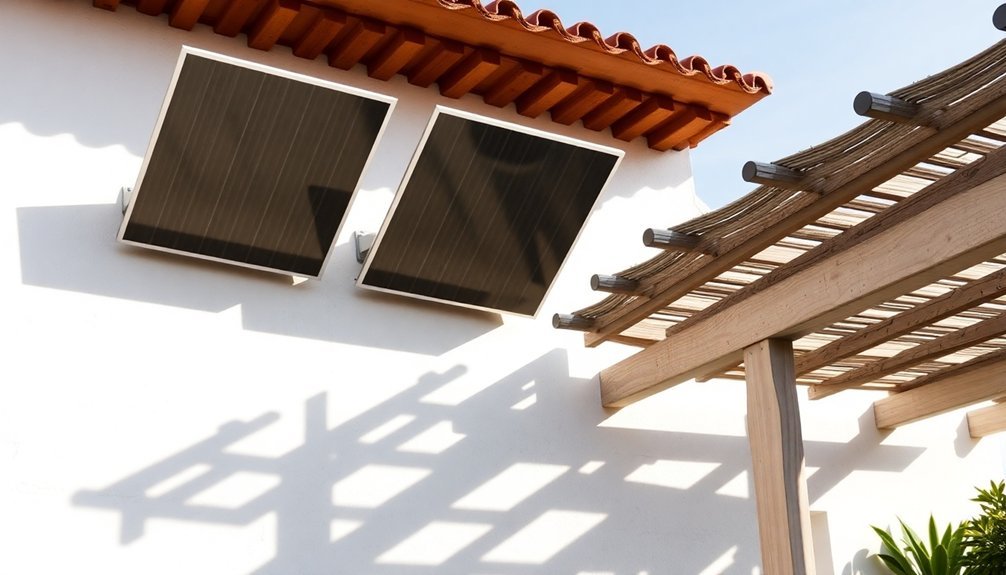
Three key elements form the foundation of Mediterranean solar design: resource assessment, technological adaptation, and economic viability.
You'll need to understand seasonal solar patterns and daily radiation variability to optimize your system's performance. Ground-measured data and satellite observations will help you make informed decisions about panel placement and orientation.
To maximize efficiency in Mediterranean conditions, you'll want to address high-temperature challenges, as panels typically lose effectiveness above 35°C. North Africa presents immense solar potential for photovoltaic installations, particularly suited for remote electrification projects.
You'll also need strategies to combat dust storms, which can greatly reduce panel output. Consider implementing regular cleaning protocols and temperature management systems.
Your design should incorporate accurate forecasting techniques for both short-term operations and long-term planning, ensuring reliable power generation and smooth grid integration.
These fundamentals will help you tap into the region's estimated 3+ TW renewable capacity.
Optimal Solar Panel Positioning
Where you position your solar panels can make or break your system's performance in Mediterranean climates. For ideal results, you'll want to face your panels true south and set them at a tilt angle between 31° and 33° annually. You can adjust these angles seasonally to maximize energy capture throughout the year. The Mediterranean region's high solar irradiance makes it particularly suitable for optimizing solar energy collection.
| Season | Tilt Angle | Best Time for Output | Energy Yield | Installation Tips |
|---|---|---|---|---|
| Winter | 55° | 10am – 2pm | Moderate | Use sturdy mounts |
| Spring | 20° | 9am – 3pm | High | Check roof integrity |
| Summer | 7° | 8am – 4pm | Maximum | Add cooling space |
| Autumn | 45° | 9am – 3pm | High | Secure against winds |
| Annual | 31-33° | 9am – 3pm | Enhanced | Professional setup |
If your roof can't accommodate south-facing panels, you can opt for an east-west configuration, which still captures significant sunlight during mornings and afternoons.
Weather Pattern Impact Analysis
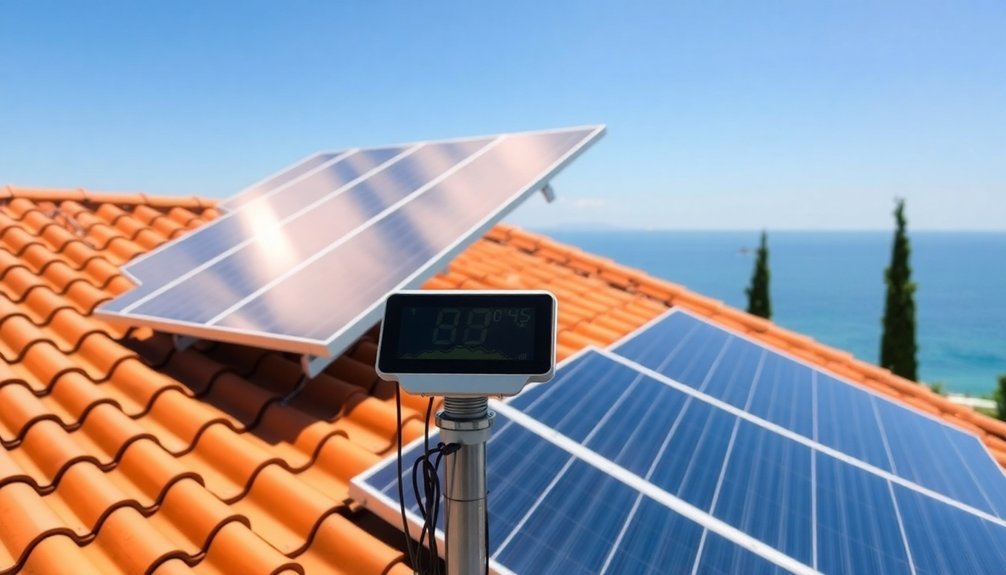
You'll find Mediterranean weather patterns create distinct seasonal challenges for solar energy production, with stronger PV generation in winter under the SSP1-2.6 scenario but reversed patterns under SSP5-8.5.
Your solar system's performance will vary considerably between seasons, as the region warms 1.5 times faster than global averages and experiences more extreme weather events. Implementing surface albedo modifications through reflective materials can help optimize energy capture during intense Mediterranean sunlight periods.
When you're planning for storms, consider that the Mediterranean's changing precipitation patterns can quickly shift from prolonged droughts to intense rainfall, affecting both panel efficiency and maintenance schedules.
Seasonal Climate Influence
Mediterranean climates display distinct seasonal patterns that directly impact solar energy collection and system performance throughout the year.
You'll find summers are typically hot and dry with reliable sunshine, making it ideal for maximum solar energy harvesting.
Winter months bring mild temperatures between 30-65°F, along with most of the region's annual rainfall of around 20 inches.
Your solar system's efficiency will vary with these seasonal shifts.
The Mediterranean Sea and other large water bodies moderate temperatures, creating stable conditions for solar installations.
You'll need to account for the almost rain-free summers and wet winters when planning your setup.
While winter precipitation might reduce solar exposure, the region's generally moderate temperatures and abundant sunshine make it highly suitable for solar energy collection throughout most of the year.
Mediterranean Storm Effects
While consistent sunshine defines much of the Mediterranean climate, powerful storm systems known as medicanes can dramatically impact your solar energy systems. You'll need to prepare for these intense storms that can bring winds up to 144 km/h and torrential rainfall, potentially damaging solar installations and reducing their efficiency.
| Storm Effect | Impact on Solar Systems |
|---|---|
| Coastal Flooding | Salt water exposure can corrode components |
| Flash Floods | Foundation damage to ground-mounted panels |
| High Winds | Panel displacement and structural stress |
| Infrastructure Damage | Power grid disruptions affecting feed-in |
These storms can also lead to extended periods of reduced solar generation due to cloud cover and debris accumulation on panels. Understanding these weather patterns helps you implement proper anchoring systems and maintenance protocols to protect your solar investment during severe Mediterranean weather events.
Energy Storage Solutions
As solar energy gains prominence in Mediterranean regions, effective storage solutions have become essential for maintaining consistent power supply.
You'll find that battery energy storage systems (BESS) offer the most practical solution for your home, converting and storing power for later use during outages or peak demand periods.
For larger installations, you can consider thermal storage systems that use fluids like molten salt or water.
These systems can store heat effectively for up to 30 years, though they'll require significant space and investment.
The Balearic Islands demonstrate successful integration of solar-plus-storage projects, combining 49.625 MW of photovoltaic capacity with 53.50 MWh of storage.
Modern energy management systems help you optimize these solutions by predicting production based on weather forecasts and balancing power generation with your specific load requirements.
Seasonal Performance Adjustments
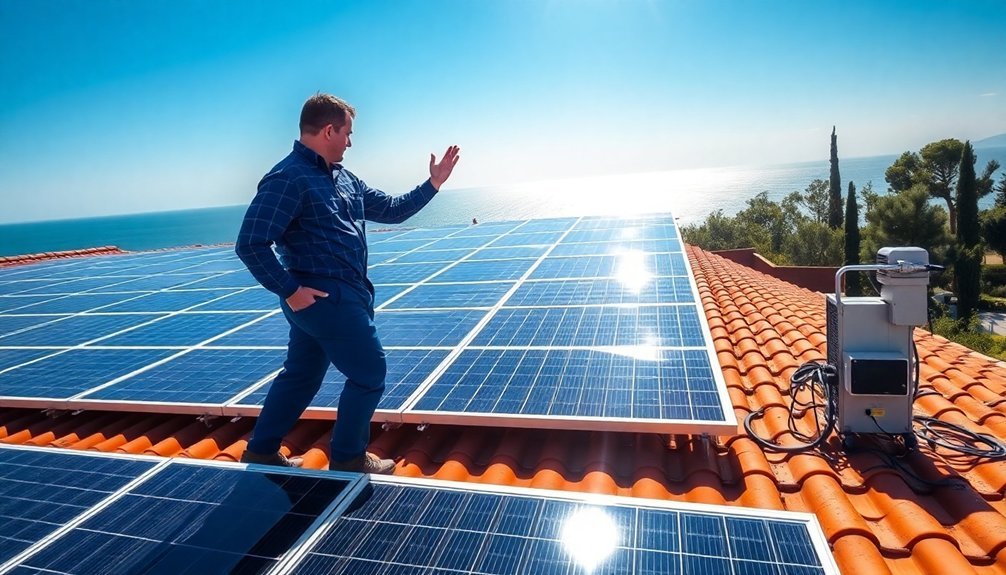
Making seasonal adjustments to your solar setup maximizes energy production throughout the year. In Mediterranean climates, you'll need to enhance your system differently for summer and winter conditions.
During summer months, you'll benefit from longer days and more direct sunlight, but you'll want to manage higher temperatures that can reduce panel efficiency.
Adjust your panels' tilt angle seasonally to capture ideal sunlight. You'll want a steeper angle in winter when the sun is lower, and a flatter angle in summer when it's higher.
While Mediterranean regions experience less dramatic seasonal variations than northern Europe, you should still account for seasonal cloud patterns.
Consider using tracking devices to automatically maintain perfect panel positioning throughout the day, especially during peak sun hours when solar intensity is strongest.
Heat Management Best Practices
You'll need a balanced approach to heat management in Mediterranean climates, starting with strategic shading systems and thermal mass materials that work together to regulate indoor temperatures.
Your ventilation design should leverage natural cross-breezes through carefully positioned windows and vents, while incorporating thermal mass elements like stone or concrete in walls and floors to absorb excess heat during peak hours.
Complement these passive strategies with adjustable exterior shutters and overhangs that block intense summer sun while allowing beneficial winter solar gain.
Shading and Cooling Systems
Mediterranean climate mastery requires effective shading and cooling systems to combat intense solar radiation.
You'll find that louvers and meshes can cut your cooling loads by 20-40%, while mesh systems with 60% opening ratios offer maximum efficiency. For best results, combine these shading solutions with natural ventilation strategies.
You can choose from various options, including venetian blinds, external perforated screens, and automated systems that adjust based on real-time conditions.
When selecting your shading device, consider both geometry and materials – the thickness-to-pitch ratio of mesh strands and louver angles (ideally 20°) greatly impact performance.
Remember to factor in embodied energy costs; confirm your chosen system's operational savings outweigh its environmental impact.
For enhanced effectiveness, integrate your shading with night-flushing techniques to prevent daytime heat buildup.
Thermal Mass Applications
Beyond shading systems, thermal mass stands as a powerful tool for temperature regulation in Mediterranean buildings.
You'll want to aim for internal areal heat capacity around 30 kJ/m²K and a decrement factor above 0.07 for ideal performance.
To maximize thermal mass benefits in Mediterranean climates, you'll need to pair it with natural cross ventilation.
If you're building inland or at higher altitudes, you'll see even better results due to cooler nights.
Consider combining your thermal mass strategy with external insulation and mechanical ventilation with heat recovery.
You can expect significant energy savings – cooling demands can drop from 33 to 18 kWh/m²·a when properly implemented.
For best results, integrate thermal mass with an airtight envelope and supply/exhaust ventilation systems, especially given predicted temperature increases of 3-6°C by century's end.
Ventilation Design Strategies
While effective ventilation design forms the cornerstone of heat management in warm climates, integrating both mechanical and natural strategies will optimize your building's thermal performance. You'll need to combine cross-ventilation techniques with automated controls and heat recovery systems for year-round comfort.
| Strategy | Benefits |
|---|---|
| Mechanical Heat Recovery | Reduces energy costs by reusing internal heat; maintains comfort in winter |
| Cross Ventilation | Maximizes natural airflow; decreases cooling loads in summer |
| Automated Controls | Optimizes window operation based on temperature and humidity; guarantees efficient air exchange |
Position your windows strategically on opposite walls to enhance airflow, and consider installing buried ducts to pre-cool summer air. You'll achieve the best results by incorporating double glazing on south-facing windows and automated bottom-hinged windows that respond to changing conditions throughout the day.
Maintenance During Weather Changes
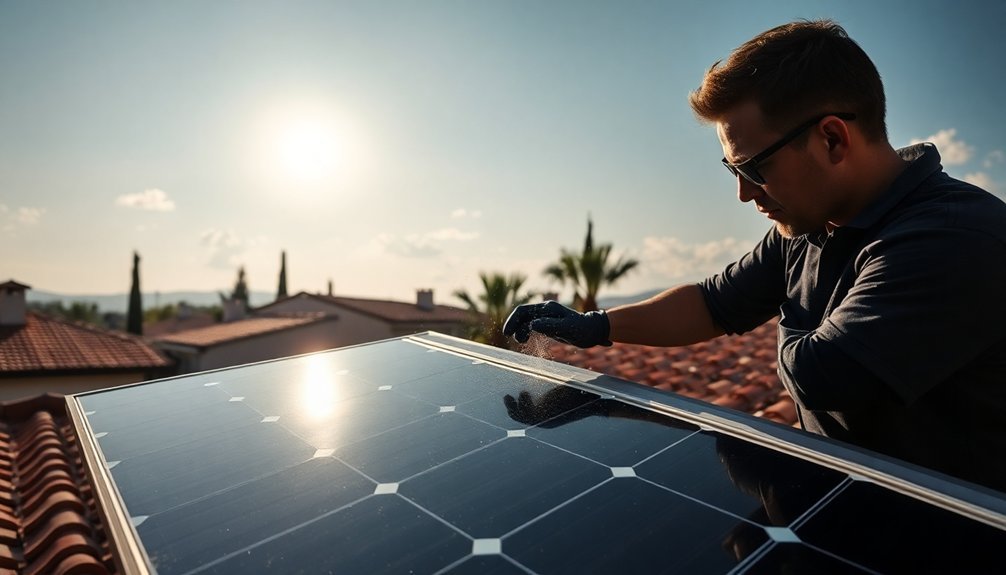
As the seasons shift throughout the Mediterranean region, solar panel maintenance requirements change dramatically to guarantee peak performance.
During sunny periods, you'll need to clean your panels every two weeks to prevent dust buildup and maintain maximum efficiency. Keep an eye on ventilation to prevent heat-related performance drops.
When rain arrives, let nature do some cleaning for you, but don't forget to check for leftover debris afterward. Watch out for algae or mold growth in humid conditions.
While snow is less common in Mediterranean areas, you should still be prepared with a soft brush for removal if needed.
After strong winds or hailstorms, inspect your mounting hardware carefully and look for any physical damage. If you spot cracks or loose brackets, contact a professional immediately for repairs.
Solar System Efficiency Monitoring
Regular maintenance keeps your solar system running smoothly, but monitoring its efficiency guarantees you're getting the most from your investment.
Modern inverters with LCD displays and mobile apps let you track energy production and system status in real-time. You'll also get instant alerts about performance issues through web portals that store historical data.
- Use environmental sensors to measure temperature, irradiance, and wind speed – factors that directly affect your panels' performance
- Track module-level metrics through platforms like Enphase Enlighten to identify underperforming panels
- Install energy meters to measure electricity production and diagnose potential issues quickly
- Enable Bluetooth connectivity for real-time data access on your smartphone, making it easier to monitor performance while you're away
Frequently Asked Questions
How Do Mediterranean Dust Storms Affect Solar Panel Warranty Coverage?
Your solar panel warranty won't cover damage from Mediterranean dust storms, as they're considered external environmental factors. You'll need additional insurance coverage to protect against dust storm-related issues and efficiency losses.
Can Solar Panels Power a Swimming Pool Heating System Effectively?
Yes, you'll find solar panels can effectively heat your pool, especially in sunny conditions. They'll typically warm the water by up to 5°C and can cover 50% of your pool's heating needs year-round.
What Insurance Considerations Should I Know for Solar Installations Near Coastlines?
You'll need increased coverage for coastal solar installations due to corrosion risks. Consider getting commercial insurance if selling energy back, and expect slightly higher premiums. Regular inspections are essential for maintaining insurance compliance.
How Do Local Building Regulations Impact Rooftop Solar Panel Aesthetics?
Local building codes can limit your panel color choices, placement, and array layout. You'll need to follow specific mounting requirements and aesthetic guidelines, while considering solutions like SolarSkin to match your roof's appearance.
Are There Special Cleaning Products Recommended for Mediterranean Coastal Solar Installations?
You'll need specialized saltwater-resistant cleaners like SolarWater capsules and hydrophobic coatings to protect your coastal panels. Don't forget neutral soaps and denatured alcohol for removing stubborn salt deposits and mineral buildup.
In Summary
You'll maximize your Mediterranean solar system's performance by implementing these expert techniques and monitoring strategies. Stay proactive with seasonal adjustments, proper heat management, and regular maintenance checks. By understanding local weather patterns and optimizing panel positioning, you're set to harness solar power efficiently year-round. Keep tracking your system's performance and adjust your energy storage solutions as needed for the best results.

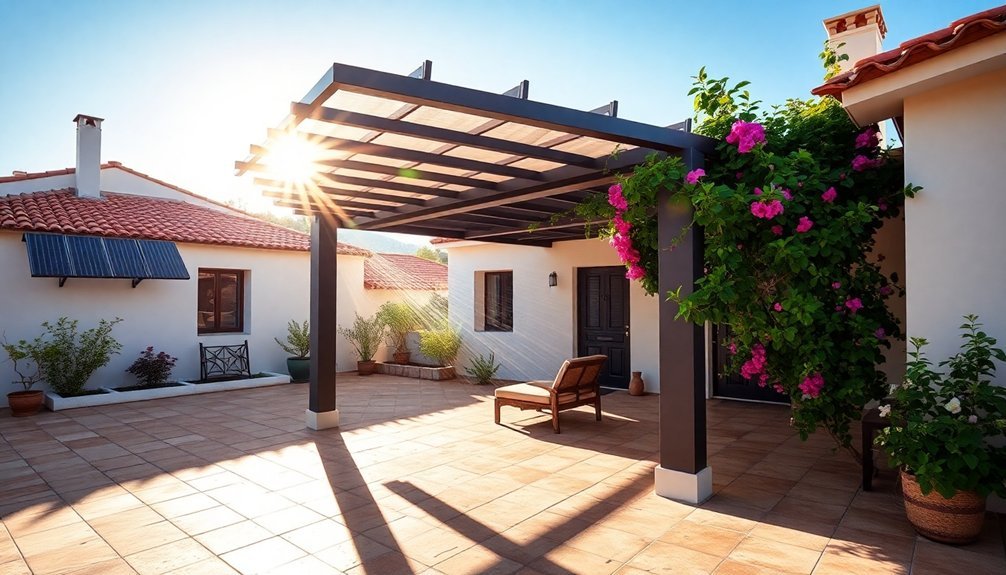
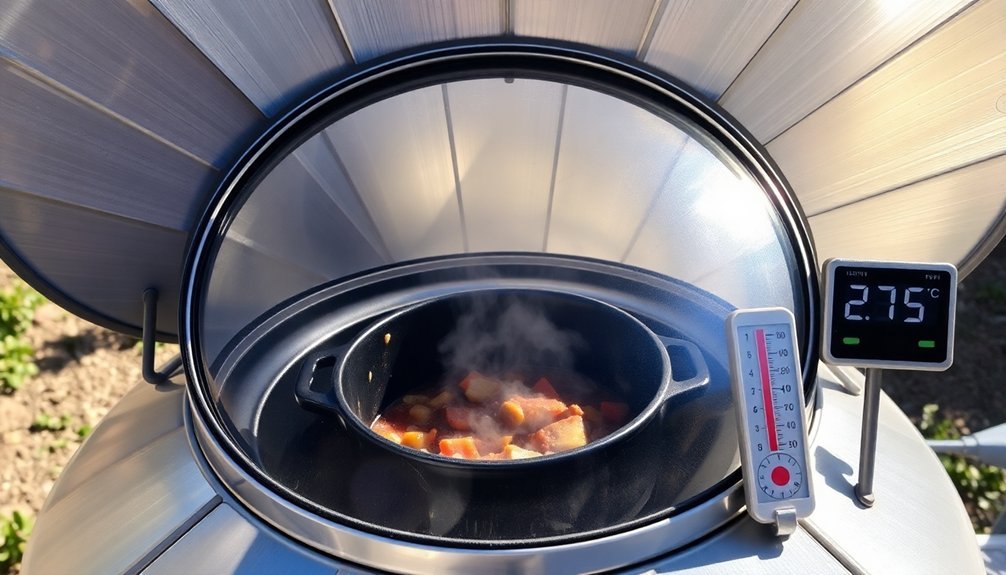
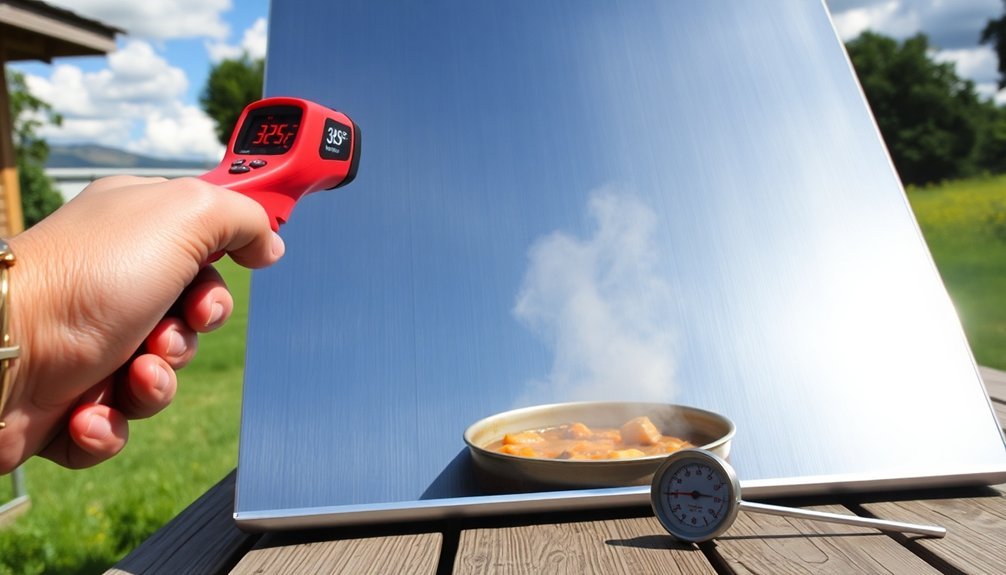
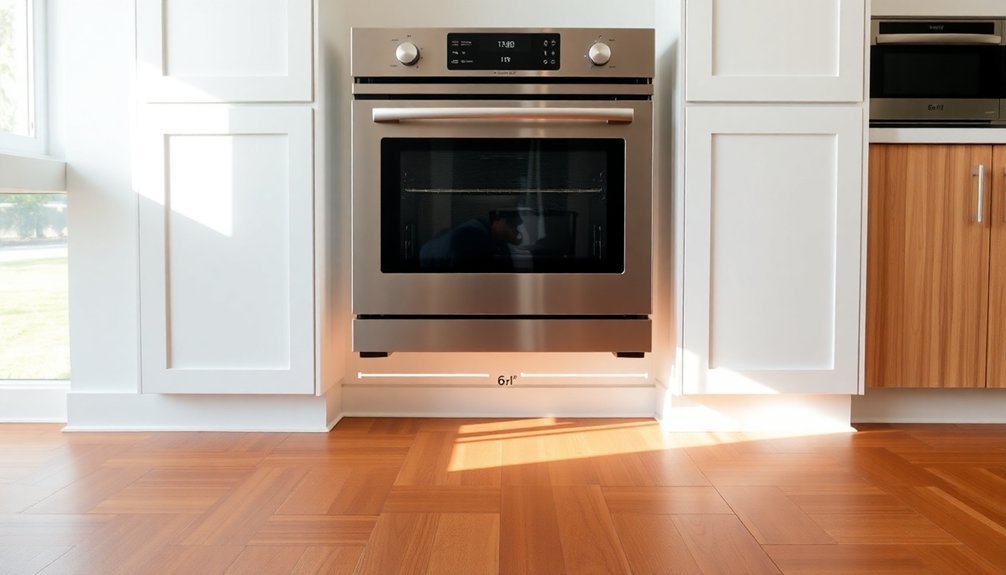
Leave a Reply